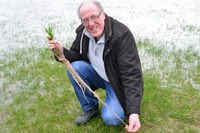A grass roots approach to flooding

Dr Mike Humphreys, IBERS
20 February 2014
Scientists at Aberystwyth University’s Institute of Biological, Environmental and Rural Sciences (IBERS), are working with partners at Rothamsted Research North Wyke in Devon to develop new grasses that enable grassland soils to capture increased volumes of rainfall, thereby reducing the risk of flooding downstream.
The 5 year £2.5 million LINK project named SUREROOT is funded by the BBSRC (Biotechnology and Biological Sciences Research Council), and match-funded by a range of industrial partners from across the food production spectrum, including a seed company, a major retailer and the meat, poultry and dairy industry.
Large areas of the UK are facing continued and widespread threats from flooding that damage UK homes, and are causing the UK economy and agricultural production significant losses (e.g. an estimated £600m in 2012). Many of our river catchments are upland grasslands predominating in the wettest areas of the UK.
If the rates of surface run-off could be reduced and rainfall captured more effectively by grassland soils, then the worst impacts of heavy rainfall down-stream may be reduced.
The SUREROOT project builds on earlier BBSRC-funded research published last year in the Nature Journal Scientific Reports (Scientific Reports SREP-12--03690.3d) where it was reported that a forage grass hybrid known as Festulolium and designed originally for livestock agriculture, also held a hidden underground and previously unknown property.
Dr Mike Humphreys of IBERS is leading the project and said: “Festulolium, which are defined as natural hybrids between ryegrass and fescue species, are very much the grasses for the future. They are the way ahead for sustainable livestock agricultural practices.
“Festulolium as a group differ widely in their attributes, but IBERS has developed options that provide for increased resilience to climate change and more water and nutrient-use efficiency together with several examples of environmental service. Their large well developed root systems combat flooding, reduce soil erosion and compaction and offer opportunities for significant carbon capture and storage at depth in soils.”
Their grass root-soil interactions instigated a change in soil structure leading to increased water retention with a prolonged and significant 51% reduction in rainfall run-off compared with equivalent grasses that were grown alongside and that are currently used extensively throughout the UK.
The SUREROOT project will assess the efficiency and effectiveness of these and other new grasses, both for their agricultural production under a range of alternative livestock management systems and for their flood mitigation properties at different locations in the UK and at different scales.
Changes will be made to grass and clover root architecture and growth patterns, and their impact on soil structure and hydrology will be evaluated if reproduced widely at the field scale.
If the initial positive findings are replicated on a large scale, this points to a significant breakthrough in flood alleviation.
The grass and clover varieties being bred at IBERS are increasingly being developed for their holistic properties that serve both to safeguard agricultural production at a time of climate change and to provide an additional ecosystem service. Climate-smart agricultural approaches will be required to take full advantage of these new developments.
Pioneering work has revealed similar properties in clover and these will also be investigated both independently and as mixtures with ryegrasses and Festulolium.
In order to achieve its objectives the SUREROOT project will employ for the first time two state-of-the-art and new BBSRC-funded National Capability Phenotype Facilities, the National Plant Phenomics Centre at IBERS, Aberystwyth University in Wales and the North Wyke Farm Platform at Rothamsted Research in Devon.
AU6914



